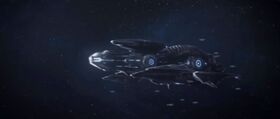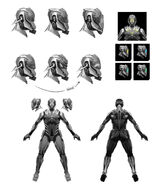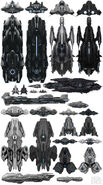
|
This article or section's title is a callsign, an alias, or a nickname, as no proper name for the subject has been revealed. You can help by adding it if it is now known. |
By approximately 150,000 BCE, Humanity had achieved a considerable level of technological sophistication, achieving interstellar travel and colonizing planets along the Orion Arm of the Milky Way galaxy.
History
Human-Flood War
After encountering the San 'Shyuum, Humanity formed an alliance, based on the planet Charum Hakkor. At this point, Humanity's technological advancement rivaled that of the Forerunners, with the Humans using Precursor artifacts to support their structures and installations.[1]
This civilization encountered the Flood in approximately 110,000 BCE and, after discovering the parasite's true nature, went to war against it. After losing many planets, Humanity desperately invaded a minor sector of the Forerunners' domain. After forty-thousand years of expansion, the collective human genus waged war with the biologically-similar Forerunner species. After considerable bloodshed and the assistance of the San 'Shyuum, the Flood were driven out of human occupied space and the few remaining Flood ships retreated out of the galaxy. However, as they had been stretched thin due to fighting two wars at once, the Humans were defeated at the hands of the Forerunners, led by the Ur-Didact.
Human-Forerunner War

Prehistoric human ship
The Humans were mistaken by the Forerunners to be aggressively expanding into their territory, attacking Forerunner worlds without reason. This was not the case as Humanity had been running and trying to get ahead of the Flood to stop it from spreading to further planets. At some point Humanity arrived at a Forerunner planet to "get ahead of the infection" although it was too late as there was already a small Flood infection outbreak on the planet. Without action this relatively small infestation would have spread and been far more difficult to contain and, as a result, the Lord of Admirals chose to attack the infection and the planet, shown in a Forerunner terminal on Requiem. This act was seen by the Forerunners, specifically the Didact, as an attack on the Forerunners and so the Forerunners went to war with Humanity in an attempt to force them to "stand with the galaxy rather than against them". Humanity and the Forerunners then went to war for years however Humanity had been exhausted fighting the Flood and by the time the Human-Flood War had been "won", Humanity had been pushed back to their capital world Charum Hakkor and had been completely cut off from any support. There, Humanity would wage a bitter last stand lasting nearly 50 years against the Forerunners which ultimately caused the deaths of the Didact's children. After their defeat at Charum Hakkor, Humanity was reduced to a pre-technological state then exiled to their homeworld, Erde-Tyrene, where they were overseen by The Librarian and her life-workers.[2] This Forerunner victory proved disastrous for the galaxy, as the Humans destroyed all their research data and physical evidence concerning the Flood, including an apparent cure to stop the parasite. Bornstellar Makes Eternal Lasting speculated it was Humanity's final act of vengeance to leave the Forerunners unprepared to face the incoming threat that led to the firing of the Halo array, Later the Didact would learn from a Gravemind that humanity did not have a cure but had been passed up by the Flood, revealing the true nature of the Flood and their far more sinister purpose. The Forerunners later learned after the defeat of Humanity that the reason for their aggression was due to them trying to stop the Flood, a foe which would later return to face the Forerunners.

Lord of Admirals looking at Forerunner planet
Forced to start again, the collective Homo genus tried in vain to reattain their former glory, with some Human communities establishing wooden cities and steam-powered waterborne vessels under the instructions of The Librarian. Most Humans, however, lived in Tier 7 tribal communities, such as the one that was encountered by the Forerunners during the construction of the portal to the Ark in eastern Africa. After the activation of the Halo Array, the Human civilization regressed once again, and would remain in a Tier 7 state for the next hundred millennia.[2]
As of the 26th century, most artifacts and records of this former civilization had been lost to time. However, ruins on the planet Heian appear to show hallmarks of Human design, suggesting that the planet was inhabited by ancient, space-faring Humans.[3][4]
Culture
Little is known about the specifics of human culture during this period, however, it is interesting to note that all the human officers shown in the terminals wore their hair long, as well as having white designs either painted or tattooed on their faces. It is unknown if women served in their military.
Known Planets and Systems
Ancient humanity's empire was said to have originally spanned over a thousand systems and twenty thousand worlds.[5]
- Charum Hakkor (Center of Human-San'Shyuum Alliance)
- Faun Hakkor (Homeworld of the Pheru)
- Ben Nauk
- Heian
- Erde Tyrene (Homeworld of Humanity)
- 13 Other Planets in the same system as Charum Hakkor
Different Subspecies Post-Human-Forerunner War
Following the war with the Forerunners, humans were splintered into a variety of more than 20 known species,[6] although not all are known. Despite being numerous species, consisting not only of human species (such as neanderthals and 'homo sapiens'), but also numerous hominids, hominoids, and anthropoids, they all thought of themselves collectively as the "People".
Before the firing of the Halo Array, the The Librarian collected many specimens, and they were reseeded after the Halo Array was fired
Although the origins of the naming of the "peoples" is unknown, it is likely the more "human" species have 'manune' in their name, and anthropoids had 'kyanunsho' in a way similar to the Elites "-ee" suffix (though one is for military service).
- B'ashamanune-skinny and lithe, scattered across equatorial grasslands[7]
- Chamanune-small, diminutive, lacking chin and reduced mandible, elegant and mobile lips[7]
- Hamanune-bronze-skinned, predominantly hairless[7]
- K'tamanune-husky, ochre and brown skinned, wandering northern latitudes and frigid climates[7]
- Denisovan-tall (at least taller than chamanune), reddish hair, square heads, and chocolate brown skin[8]
- An early form of Aborigines[8]
- Sha'kyanunsho'-anthropoid, almost 3 meters at just shoulders and crest, shadow colored[8]
- Numerous Others
Known individuals
Appearances
- Halo Legends
- The Babysitter (First appearance)
- Halo: Evolutions - Essential Tales of the Halo Universe
- Halo: Cryptum
- Halo: Primordium
- Halo 4
Gallery
Concept Art
Trivia
- The warpaint worn by the Lord of the Admirals Forthencho is reminiscent of Native American warpaint
- The Prehistoric human fighters are not dissimilar of UNSC Sabres or Broadswords
- The warpaint shown may be representative of position in the military/on the ship
- The bridge appears to be outfitted with a single large window giving visibility as opposed to security much in the same way that UNSC ships do, it is also logical to assume that the bridge is situated towards the front of the ship, also like the UNSC
- The larger ship in the fleet shown in the Halo 4 terminal videos has a large possibly plasma based cannon on its fore-section that resembles the nose of the Covenant needler and it's placement is similar to that of the MAC cannon on certain UNSC ships
- The smaller ships seen in the Halo 4 terminal videos somewhat resemble Covenant CCS-class battlecruisers
- The energy weapons used by the Prehistoric human soldiers appear to shatter their targets like glass upon impact.
Sources
- ↑ Template:Cite book
- ↑ 2.0 2.1 Template:Cite book
- ↑ Halo Legends - The Babysitter
- ↑ Halo: Evolutions - Essential Tales of the Halo Universe - From the Office of Dr. William Arthur Iqbal
- ↑ Halo: Primordium, p. 129
- ↑ Template:Cite book
- ↑ 7.0 7.1 7.2 7.3 Cryptum Glossary Halo Official Site
- ↑ 8.0 8.1 8.2 Halo: Primordium "Page 169"














